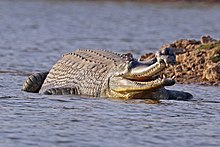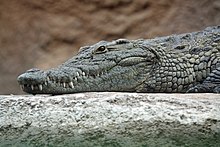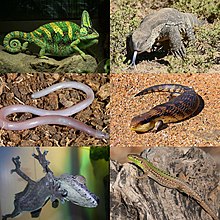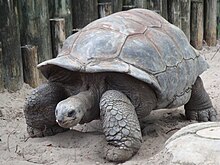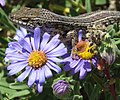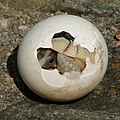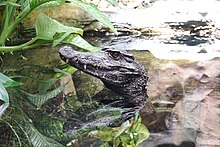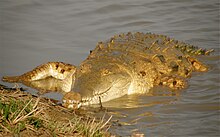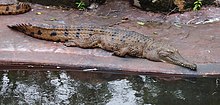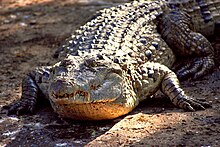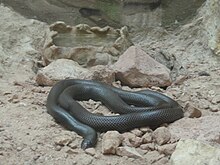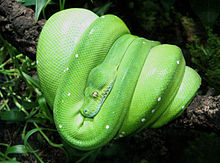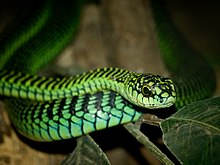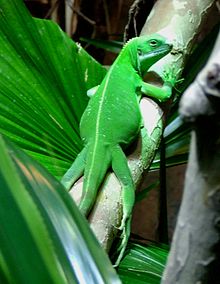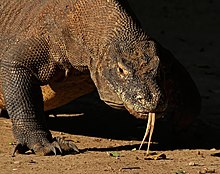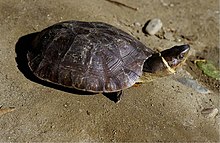Portal:Reptiles
Portal maintenance status: (June 2018)
|
The Reptiles Portal
Reptiles, as commonly defined, are a group of tetrapods with an ectothermic ('cold-blooded') metabolism and amniotic development. Living reptiles comprise four orders: Testudines (turtles), Crocodilia (crocodilians), Squamata (lizards and snakes), and Rhynchocephalia (the tuatara). As of May 2023, about 12,000 living species of reptiles are listed in the Reptile Database. The study of the traditional reptile orders, customarily in combination with the study of modern amphibians, is called herpetology.
Reptiles have been subject to several conflicting taxonomic definitions. In Linnaean taxonomy, reptiles are gathered together under the class Reptilia (/rɛpˈtɪliə/ rep-TIL-ee-ə), which corresponds to common usage. Modern cladistic taxonomy regards that group as paraphyletic, since genetic and paleontological evidence has determined that birds (class Aves), as members of Dinosauria, are more closely related to living crocodilians than to other reptiles, and are thus nested among reptiles from an evolutionary perspective. Many cladistic systems therefore redefine Reptilia as a clade (monophyletic group) including birds, though the precise definition of this clade varies between authors. Others prioritize the clade Sauropsida, which typically refers to all amniotes more closely related to modern reptiles than to mammals.
The earliest known proto-reptiles originated from the Carboniferous period, having evolved from advanced reptiliomorph tetrapods which became increasingly adapted to life on dry land. The earliest known eureptile ("true reptile") was Hylonomus, a small and superficially lizard-like animal which lived in Nova Scotia during the Bashkirian age of the Late Carboniferous, around 318 million years ago. Genetic and fossil data argues that the two largest lineages of reptiles, Archosauromorpha (crocodilians, birds, and kin) and Lepidosauromorpha (lizards, and kin), diverged during the Permian period. In addition to the living reptiles, there are many diverse groups that are now extinct, in some cases due to mass extinction events. In particular, the Cretaceous–Paleogene extinction event wiped out the pterosaurs, plesiosaurs, and all non-avian dinosaurs alongside many species of crocodyliforms and squamates (e.g., mosasaurs). Modern non-bird reptiles inhabit all the continents except Antarctica. (Full article...)
Reptile types
-
Image 1
The gharial (Gavialis gangeticus), also known as gavial or fish-eating crocodile, is a crocodilian in the family Gavialidae and among the longest of all living crocodilians. Mature females are 2.6 to 4.5 m (8 ft 6 in to 14 ft 9 in) long, and males 3 to 6 m (9 ft 10 in to 19 ft 8 in). Adult males have a distinct boss at the end of the snout, which resembles an earthenware pot known as a ghara, hence the name "gharial". The gharial is well adapted to catching fish because of its long, narrow snout and 110 sharp, interlocking teeth. (Full article...) -
Image 2Blanus cinereus, Spain
Amphisbaenia /æmfɪsˈbiːniə/ (called amphisbaenians or worm lizards) is a group of typically legless lizards, comprising over 200 extant species. Amphisbaenians are characterized by their long bodies, the reduction or loss of the limbs, and rudimentary eyes. As many species have a pink body and scales arranged in rings, they have a superficial resemblance to earthworms. While the genus Bipes retains forelimbs, all other genera are limbless. Phylogenetic studies suggest that they are nested within Lacertoidea, closely related to the lizard family Lacertidae. Amphisbaenians are widely distributed, occurring in North America, Europe, Africa, South America, Western Asia and the Caribbean. Most species are less than 6 inches (15 cm) long. (Full article...) -
Image 3Yacare caiman, Caiman yacare
A caiman (/ˈkeɪmən/ (also spelled cayman) from Taíno kaiman[additional citation(s) needed]) is an alligatorid belonging to the subfamily Caimaninae, one of two primary lineages within the Alligatoridae family, the other being alligators. Caimans are native to Central and South America and inhabit marshes, swamps, lakes, and mangrove rivers. They have scaly skin and live a fairly nocturnal existence. They are relatively small-sized crocodilians with an average maximum weight of 6 to 40 kg (13 to 88 lb) depending on species, with the exception of the black caiman (Melanosuchus niger), which can grow more than 4 m (13 ft) in length and weigh in excess of 450 kg (1,000 Ib). The black caiman is the largest caiman species in the world and is found in the slow-moving rivers and lakes that surround the Amazon basin. The smallest species is the Cuvier's dwarf caiman (Paleosuchus palpebrosus), which grows to 1.2 to 1.5 m (3.9 to 4.9 ft) long. There are six different species of caiman found throughout the watery jungle habitats of Central and Southern America. The average length for most of the other caiman species is about 2 to 2.5 m (6.6 to 8.2 ft) long. (Full article...) -
Image 4
Turtles are reptiles of the order Testudines, characterized by a special shell developed mainly from their ribs. Modern turtles are divided into two major groups, the Pleurodira (side necked turtles) and Cryptodira (hidden necked turtles), which differ in the way the head retracts. There are 360 living and recently extinct species of turtles, including land-dwelling tortoises and freshwater terrapins. They are found on most continents, some islands and, in the case of sea turtles, much of the ocean. Like other amniotes (reptiles, birds, and mammals) they breathe air and do not lay eggs underwater, although many species live in or around water. (Full article...) -
Image 5Nile crocodile (Crocodylus niloticus)
Crocodiles (family Crocodylidae) or true crocodiles are large semiaquatic reptiles that live throughout the tropics in Africa, Asia, the Americas and Australia. The term crocodile is sometimes used even more loosely to include all extant members of the order Crocodilia, which includes the alligators and caimans (family Alligatoridae), the gharial and false gharial (family Gavialidae) among other extinct taxa. (Full article...) -
Image 6Clockwise from top left: veiled chameleon (Chamaeleo calyptratus), rock monitor (Varanus albigularis), common blue-tongued skink (Tiliqua scincoides), Italian wall lizard (Podarcis sicula), giant leaf-tailed gecko (Uroplatus fimbriatus), and legless lizard (Anelytropsis papillosus)
Lizard is the common name used for all squamate reptiles other than snakes (and to a lesser extent amphisbaenians), encompassing over 7,000 species, ranging across all continents except Antarctica, as well as most oceanic island chains. The grouping is paraphyletic as some lizards are more closely related to snakes than they are to other lizards. Lizards range in size from chameleons and geckos a few centimeters long to the 3-meter-long Komodo dragon. (Full article...) -
Image 7Aldabra giant tortoise
(Aldabrachelys gigantea)
Tortoises (/ˈtɔːrtəs.ɪz/ TOR-təs-iz) are reptiles of the family Testudinidae of the order Testudines (Latin for "tortoise"). Like other turtles, tortoises have a shell to protect from predation and other threats. The shell in tortoises is generally hard, and like other members of the suborder Cryptodira, they retract their necks and heads directly backward into the shell to protect them. (Full article...) -
Image 8
The tuatara (Sphenodon punctatus) is a species of reptile endemic to New Zealand. Despite its close resemblance to lizards, it is part of a distinct lineage, the order Rhynchocephalia. The name tuatara is derived from the Māori language and means "peaks on the back". (Full article...) -
Image 9
Snakes are elongated, limbless reptiles of the suborder Serpentes (/sɜːrˈpɛntiːz/). Like all other squamates, snakes are ectothermic, amniote vertebrates covered in overlapping scales. Many species of snakes have skulls with several more joints than their lizard ancestors, enabling them to swallow prey much larger than their heads (cranial kinesis). To accommodate their narrow bodies, snakes' paired organs (such as kidneys) appear one in front of the other instead of side by side, and most have only one functional lung. Some species retain a pelvic girdle with a pair of vestigial claws on either side of the cloaca. Lizards have independently evolved elongate bodies without limbs or with greatly reduced limbs at least twenty-five times via convergent evolution, leading to many lineages of legless lizards. These resemble snakes, but several common groups of legless lizards have eyelids and external ears, which snakes lack, although this rule is not universal (see Amphisbaenia, Dibamidae, and Pygopodidae). (Full article...) -
Image 10An American alligator (top) and a Chinese alligator
An alligator, or colloquially gator, is a large reptile in the genus Alligator of the family Alligatoridae of the order Crocodilia. The two extant species are the American alligator (A. mississippiensis) and the Chinese alligator (A. sinensis). Additionally, several extinct species of alligator are known from fossil remains. Alligators first appeared during the late Eocene epoch about 37 million years ago. (Full article...)
Selected images
-
Image 1Photo credit: PollinatorThe Carolina Anole is a lizard found primarily in the south eastern parts of the United States. It has color-changing abilities, although it is not a chameleon. This lizard can reach a total length of about 22 cm. The male has a pink or red dewlap that extends from his chin. Green Anoles can have a green or a brown body colour, which depends on mood and climate.
-
Image 2Cerastes cerastes, commonly known as the Saharan horned viper or the horned desert viper, is a venomous species of viper native to the deserts of northern Africa and parts of the Arabian Peninsula and Levant. It often is easily recognized by the presence of a pair of supraocular "horns", although hornless individuals do occur.
-
Image 3Photograph credit: Charles James SharpCalumma crypticum, the blue-legged chameleon, is a species of chameleon found in eastern Madagascar. As with other chameleons, an individual's colour is variable and depends on its surroundings, the ambient temperature, and variations in the level of light. The species is usually quite colourful, with rich browns, blues and greens; the legs are often marked with blue. This C. crypticum individual was photographed in Ranomafana National Park, Madagascar, and can be identified as a male by its long snout with a horn-like protrusion.
-
Image 4Leiocephalus personatus is a species of curly-tailed lizard first described by Edward Drinker Cope in 1862. This specimen was photographed in the reptile zoo of Neu-Ulm, Germany.
-
Image 5Photo credit: Marcel Burkhard (cele4)The Plumed Basilisk (Basiliscus plumifrons) is a species of lizard native to Latin America. Its natural range covers a swath from Mexico to Ecuador.
-
Image 6The American five-lined skink (Eumeces fasciatus) is one of the most common lizards in the eastern United States, as well as one of the five lizard species extant in Canada. It is a small to medium sized skink growing to about 12.5 to 21.5 cm (4.9 to 8.5 in). Juveniles (as seen here) are dark brown to black with five distinctive white to yellowish stripes running along the body and a bright blue tail.
-
Image 7Asian vine snake Ahaetulla prasina. This snake has a wide distribution in Asia. It feeds on small reptiles and amphibians, particularly lizards and tree frogs. Adults may attain 1.8 m (6 feet) in total length, with a tail 0.6 m (2 feet) long. Its appearance is very much like those of South American vine snakes. It is a rear-fanged species and is mildly venomous but is not considered a threat to humans.
-
Image 8Cape skink – Trachylepis capensis. Close-up on purple Aster flowers.
-
Image 9Photograph: Didier DescouensA fossil of Steneosaurus bollensis, from the extinct genus of teleosaurid crocodyliforms Steneosaurus. This specimen was found in Holzmaden, Germany, and dates from the Early Jurassic (185 million years ago).
-
Image 10Photograph: Charles J. SharpThe yacare caiman (Caiman yacare) is a species of caiman found in central South America. About ten million individuals, such as this one, exist within the Brazilian pantanal, representing what may be the largest single crocodilian population on Earth. This small-to-medium sized species feeds mainly on fish (especially piranha), but also eats birds, reptiles, and small mammals.
-
Image 11Photo: Benjamint444The marine iguana (Amblyrhynchus cristatus) is an iguana found only on the Galápagos Islands that has the ability, unique among modern lizards, to live and forage in the sea, making it a marine reptile. It can dive over 10 m (33 ft) deep and mainly lives on the rocky coasts, but can also be spotted in marshes and mangrove beaches.
-
Image 12Photograph: Geoff GalliceBothriechis schlegelii is a venomous pit viper species found in Central and South America. Small and arboreal, these snakes are characterized by their wide array of color variations, as well as the superciliary scales over the eyes. They are the most common of the palm-pitvipers and are often present in zoological exhibits. The specific name schlegelii honors the German ornithologist, Hermann Schlegel. No subspecies are currently recognized.
-
Image 14Photograph credit: Charles James SharpThe Malagasy giant chameleon (Furcifer oustaleti) is a large species of chameleon, endemic to Madagascar. As well as the insects and small vertebrates on which the species feeds, it sometimes consumes fruit. It has been observed drawing fruit-bearing twigs closer with its forelimbs, a degree of food manipulation unusual in reptiles. This juvenile Malagasy giant chameleon was photographed at night in Montagne d'Ambre National Park.
-
Image 15Photograph: Benny TrappThe Sicilian wall lizard (Podarcis waglerianus) is a species of lizard in the family Lacertidae. Endemic to Italy, it occurs in temperate forests, temperate shrubland, Mediterranean-type shrubby vegetation, temperate grassland, arable land, pastureland, and rural gardens in Sicily and the Aegadian Islands. The species' numbers are generally stable, and it has been listed as Least Concern by the IUCN.
-
Image 16The Northern Curly-tailed Lizard (Leiocephalus carinatus) is a lizard species from the family of curly-tailed lizards (Leiocephalidae). It is native to the Bahamas, the Cayman Islands and Cuba, but was released intentionally in Palm Beach, Florida, in the 1940s. An active, robust lizard, it is mostly terrestrial and will retreat into a burrow or cavity when frightened. It prefers sunny areas with loose rubble and rock.
-
Image 19A baby marginated tortoise hatchling emerges from its shell.
-
Image 21Photograph: Didier DescouensBarracudasauroides is a genus of mixosaurid ichthyosaur which lived during the Middle Triassic. Fossils of this genus have been found in Guizhou Province, China. It is known from GMPKU-P-1033, a partial skeleton recovered from the Upper Member of the Guanling Formation in the Xinmin.
-
Image 22Photo credit: John O'NeillThe Eastern Bearded Dragon (Pogona barbata) is a lizard found in wooded parts of Australia. It is a large species of grey-black colour distinguished from its relative, the Central Bearded Dragon, by its less robust body and the row of spines along the lateral edge of the body, which continues over the forearm. It has an adult snout-tail length of about 60 cm (24 in).
-
Image 23Photograph: Benny TrappVipera dinniki is a species of venomous viper which can reach 48.6 cm (19.1 in) in length. First described by Alexander Nikolsky in 1913, V. dinniki is found in the highlands of Russia, Georgia, and Azerbaijan.
-
Image 24Photo credit: Paul HirstAn anole lizard of the family Polychrotidae found in Hilo, Hawaii, United States. Anoles are small and common lizards that can be found throughout the various regions of the Western Hemisphere. They are frequently and incorrectly called chameleons or geckos due to their ability to alter their skin color and run up walls, respectively.
-
Image 25Photo: Muhammad Mahdi KarimA White-headed dwarf gecko (Lygodactylus picturatus) whose tail is missing due to autotomy, the act of an animal severing its own appendages, usually as a self-defense mechanism designed to elude a predator's grasp. The detached tail will continue to wriggle, distracting the predator's attention. The lost body part may be regenerated later.
Selected Crocodilia articles
-
Image 1At Le Bonheur Crocodile Farm near Stellenbosch, South Africa
The Nile crocodile (Crocodylus niloticus) is a large crocodilian native to freshwater habitats in Africa, where it is present in 26 countries. It is widely distributed in sub-Saharan Africa, occurring mostly in the eastern, southern, and central regions of the continent, and lives in different types of aquatic environments such as lakes, rivers, swamps and marshlands. It occasionally inhabits deltas, brackish lakes and rarely also saltwater. Its range once stretched from the Nile Delta throughout the Nile River. Lake Turkana in Kenya has one of the largest undisturbed Nile crocodile populations.
Generally, the adult male Nile crocodile is between 3.5 and 5 m (11 ft 6 in and 16 ft 5 in) in length and weighs 225 to 750 kg (496 to 1,653 lb). However, specimens exceeding 6.1 m (20 ft) in length and 1,000 kg (2,200 lb) in weight have been recorded. It is the largest predator in Africa, and may be considered the second-largest extant reptile in the world, after the saltwater crocodile (Crocodylus porosus). Size is sexually dimorphic, with females usually about 30% smaller than males. The crocodile has thick, scaly, heavily armoured skin. (Full article...) -
Image 2

The black caiman (Melanosuchus niger) is a crocodilian reptile endemic to South America. With a maximum length of around 5 to 6 m (16 to 20 ft) and a mass of over 450 kg (1,000 lb), it is the largest living species of the family Alligatoridae, and the third-largest crocodilian in the Neotropical realm. True to its common and scientific names, the black caiman has a dark greenish-black coloration as an adult. In some individuals, the pigmentation can appear almost jet-black. It has grey to brown banding on the lower jaw; juveniles have a more vibrant coloration compared to adults, with prominent white-pale yellow banding on the flanks that remains present well into adulthood (more than most other species). The banding on young animals helps with camouflage by breaking up their body outline, on land or in water, in an effort to avoid predation. The morphology is quite different from other caimans but the bony ridge that occurs in other caimans is present. The head is large and heavy, an advantage in catching larger prey. Like all crocodilians, caimans are long, squat creatures, with big jaws, long tails and short legs. They have thick, scaled skin, and their eyes and noses are located on the tops of their heads. This enables them to see and breathe while the rest of their bodies are underwater.
A carnivorous animal, the black caiman lives along freshwater habitats, including slow-moving rivers, lakes and seasonally flooded savannas, where it preys upon a variety of fish, reptiles, birds, and mammals. Being an apex predator and potentially a keystone species, it is generalist, capable of taking most animals within its range, and might have played a critical role in maintaining structure of the ecosystem. Although merely few specific ecological studies have been conducted, it is observed that this species has its own niche which allows coexistence with other competitors. (Full article...) -
Image 3
Mecistops is a genus of crocodiles, the slender-snouted crocodiles, native to sub-Saharan Africa. (Full article...) -
Image 4Mato Grosso, Brazil
The yacare caiman (Caiman yacare), also known commonly as the jacare caiman, Paraguayan caiman, piranha caiman, red caiman, and southern spectacled caiman, is a species of caiman, a crocodilian in the family Alligatoridae. The species is endemic to Argentina, Bolivia, Brazil, and Paraguay. Brown in color and covered with dark blotches, males grow to a total length (including tail) of 2–3 m (6 ft 7 in – 9 ft 10 in) and weigh around 40–50 kg (88–110 lb); while females grow to 1.4 m (4 ft 7 in) long and about 15–20 kg (33–44 lb). Typical habitats of this caiman include lakes, rivers, and wetlands. Its diet primarily consists of aquatic animals, such as snails, and occasionally land vertebrates. Mating occurs in the rainy season and eggs hatch in March, with young fending for themselves as soon as they hatch. The yacare caiman was hunted heavily for its skin to use for leather in the 1980s, which caused its population to decrease significantly. However, trading restrictions placed since have caused its population to increase. Its population in the Pantanal is about 10 million, and it is listed as least concern on the IUCN Red List. (Full article...) -
Image 5A smooth-fronted caiman at Zoologischer Garten Berlin in Berlin, Germany
The smooth-fronted caiman (Paleosuchus trigonatus), also known as Schneider's dwarf caiman or Schneider's smooth-fronted caiman, is a crocodilian from South America, where it is native to the Amazon and Orinoco Basins. It is the second-smallest species of the family Alligatoridae, the smallest being Cuvier's dwarf caiman, also from tropical South America and in the same genus. An adult typically grows to around 1.2 to 1.6 m (3.9 to 5.2 ft) in length and weighs between 9 and 20 kg (20 and 44 lb). Exceptionally large males can reach as much as 2.3 m (7.5 ft) in length and 36 kg (79 lb) in weight. (Full article...) -
Image 6
The Siamese crocodile (Crocodylus siamensis) is a medium-sized freshwater crocodile native to Indonesia (Borneo and possibly Java), Brunei, East Malaysia, Laos, Cambodia, Myanmar, Thailand and Vietnam. The species is critically endangered and already extirpated from many regions. Its other common names include Siamese freshwater crocodile, Singapore small-grain, and soft-belly. (Full article...) -
Image 7
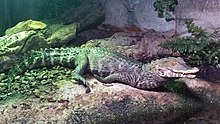
Cuvier's dwarf caiman (Paleosuchus palpebrosus) is a small crocodilian in the alligator family from northern and central South America. It is found in Bolivia, Brazil, Colombia, Ecuador, French Guiana, Guyana, Paraguay, Peru, Suriname, Trinidad and Venezuela. It lives in riverine forests, flooded forests near lakes, and near fast-flowing rivers and streams. It can traverse dry land to reach temporary pools and tolerates colder water than other species of caimans. Other common names for this species include the musky caiman, the dwarf caiman, Cuvier's caiman, and the smooth-fronted caiman (the latter name is also used for P. trigonatus). It is sometimes kept in captivity as a pet and may be referred to as the wedge-head caiman by the pet trade community.
Cuvier's dwarf caiman was first described by the French zoologist Georges Cuvier in 1807 and is one of only two species in the genus Paleosuchus, the other species being P. trigonatus. Their closest relatives are the other caimans in the subfamily Caimaninae. With a total length averaging 1.4 m (4.6 ft) for males and up to 1.2 m (3.9 ft) for females, Cuvier's dwarf caiman is not only the smallest extant species in the alligator and caiman family, but also the smallest of all crocodilians (unless the Congo dwarf crocodile is considered a valid species). An adult weighs around 5 to 7 kg (11 to 15 lb). Its lack of size is partly made up for by its strong body armor, provided by the bony bases to its dermal scales, which provides protection against predators. Juvenile dwarf caimans mainly feed on invertebrates, but also small fish and frogs, while adults eat larger fish, amphibians, and invertebrates, such as large molluscs. This caiman sometimes uses a burrow as shelter during the day and in the Pantanal may aestivate in the burrow to stay cool in the dry season. The female buries her eggs on a mounded nest and these take about 3 months to hatch. She helps the hatchlings to escape from the nest and provides some parental care for the first few weeks of their lives. This caiman has a wide range and large total population and the IUCN lists its conservation status as being of least concern. (Full article...) -
Image 8
The spectacled caiman (Caiman crocodilus), also known as the white caiman, common caiman, and speckled caiman, is a crocodilian in the family Alligatoridae. It is brownish-, greenish-, or yellowish-gray colored and has a spectacle-like ridge between its eyes, which is where its common name come from. It grows to a length of 1.4–2.5 m (4 ft 7 in – 8 ft 2 in) and a weight of 7–40 kg (15–88 lb), with males being both longer and heavier than females. Its diet varies seasonally, commonly consisting of crabs, fish, small mammals, amphibians and snails. Breeding occurs from May to August and 14–40 eggs are laid in July and August. This crocodilian has a large range and population; it is native to much of Latin America, and has been introduced to the United States, Cuba, and Puerto Rico. (Full article...) -
Image 9
The Orinoco crocodile (Crocodylus intermedius) is a critically endangered crocodile. Its population is very small, and they can only be found in the Orinoco river basin in Venezuela and Colombia. Extensively hunted for their skins in the 19th and 20th centuries, it is one of the most endangered species of crocodiles. It is a very large species of crocodilian; males have been reported up to 6.8 m (22 ft 4 in) in the past, weighing over 900 kg (2,000 lb), but such sizes do not exist today, 5.2 m (17 ft 1 in) being a more widely accepted maximum size. A large male today may attain 4.2 m (13 ft 9 in) in length and can weigh up to 450 kg (1,000 lb), while females are substantially smaller with the largest likely to weigh around 225 kg (496 lb). Sexual dimorphism is not as profound as in other crocodilian species. The coloration is light even in adults.
The ecology of the Orinoco crocodile is poorly documented in the wild, mostly due to its small population. It is thought to have a more piscivorous diet with an opportunistic nature, resulting in generalist predatory behaviour. It is an apex predator and preys on a variety of birds, mammals and reptiles, including caimans on occasion. Its prey base is mostly large predatory fish, challenging the general view by locals complaining about crocodiles hunting local fish to very low numbers. Reproduction takes place in the dry season when the water level is low. It is a hole nester and digs holes in the sand for its clutch of eggs. The females guard the nests and young for several years. (Full article...) -
Image 10
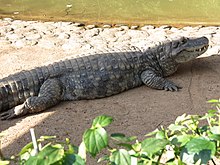
The broad-snouted caiman (Caiman latirostris) is a crocodilian in the family Alligatoridae found in eastern and central South America, including the Pantanal habitat of Bolivia, Southeast Brazil, and Paraguay, as well as northern Argentina and Uruguay. Behind the black caiman (Melanosuchus niger), it is the second-largest caiman species; it is the third-largest alligatorid behind the American alligator (Alligator mississippiensis) and the aforementioned black caiman. Primarily, the species inhabits freshwater wetlands, including floodplains, marshes, swamps, and some mangrove forests, as well as various streams, rivers, lakes or ponds, preferring bodies of rather still or slower-moving water. They will often utilize man-made cow ponds, disused stock tanks, and canals and ditches, as well. (Full article...) -
Image 11
The gharial (Gavialis gangeticus), also known as gavial or fish-eating crocodile, is a crocodilian in the family Gavialidae and among the longest of all living crocodilians. Mature females are 2.6 to 4.5 m (8 ft 6 in to 14 ft 9 in) long, and males 3 to 6 m (9 ft 10 in to 19 ft 8 in). Adult males have a distinct boss at the end of the snout, which resembles an earthenware pot known as a ghara, hence the name "gharial". The gharial is well adapted to catching fish because of its long, narrow snout and 110 sharp, interlocking teeth.
The gharial probably evolved in the northern Indian subcontinent. Fossil gharial remains were excavated in Pliocene deposits in the Sivalik Hills and the Narmada River valley. It currently inhabits rivers in the plains of the northern part of the Indian subcontinent. It is the most thoroughly aquatic crocodilian, and leaves the water only for basking and building nests on moist sandbanks. Adults mate at the end of the cold season. Females congregate in spring to dig nests, in which they lay 20–95 eggs. They guard the nests and the young, which hatch before the onset of the monsoon. The hatchlings stay and forage in shallow water during their first year, but move to sites with deeper water as they grow. (Full article...) -
Image 12At the Columbus Zoo and Aquarium in Powell, Ohio
The American alligator (Alligator mississippiensis), sometimes referred to as a gator, or common alligator is a large crocodilian reptile native to the Southeastern United States and a small section of northeastern Mexico. It is one of the two extant species in the genus Alligator, and is larger than the only other living alligator species, the Chinese alligator.
Adult male American alligators measure 3.4 to 4.6 m (11.2 to 15.1 ft) in length, and can weigh up to 500 kg (1,100 lb), with unverified sizes of up to 5.84 m (19.2 ft) and weights of 1,000 kg (2,200 lb) making it the second largest member by length and the heaviest of the family Alligatoridae, after the black caiman. Females are smaller, measuring 2.6 to 3 m (8.5 to 9.8 ft) in length. The American alligator inhabits subtropical and tropical freshwater wetlands, such as marshes and cypress swamps, from southern Texas to North Carolina. It is distinguished from the sympatric American crocodile by its broader snout, with overlapping jaws and darker coloration, and is less tolerant of saltwater but more tolerant of cooler climates than the American crocodile, which is found only in tropical and warm subtropical climates. (Full article...) -
Image 13

The Chinese alligator (Alligator sinensis; simplified Chinese: 鼍; traditional Chinese: 鼉; pinyin: tuó), also known as the Yangtze alligator (simplified Chinese: 扬子鳄; traditional Chinese: 揚子鱷; pinyin: yángzǐ'è), China alligator, or historically the muddy dragon, is a crocodilian endemic to China. It and the American alligator (A. mississippiensis) are the only living species in the genus Alligator of the family Alligatoridae. Dark gray or black in color with a fully armored body, the Chinese alligator grows to 1.5–2.1 metres (5–7 ft) in length and weighs 36–45 kilograms (80–100 lb) as an adult. It brumates in burrows in winter and is nocturnal in summer. Mating occurs in early summer, with females most commonly producing 20–30 eggs, which are smaller than those of any other crocodilian. The species is an opportunistic feeder, primarily eating fish and invertebrates. A vocal species, adults bellow during the mating season and young vocalize to communicate with their parents and other juveniles. Captive specimens have reached age 70, and wild specimens can live past 50.
Living in bodies of fresh water, the Chinese alligator's range is restricted to six regions in the province of Anhui, as well as possibly the provinces of Jiangsu and Zhejiang. Originally living as far away from its current range as Japan, the species previously had a wide range and population, but beginning in 6000 BC, multiple threats, such as habitat destruction, caused the species' population and range to decline. The population in the wild was about 1,000 in the 1970s, decreased to below 130 in 2001, and grew after 2003, with its population being about 300 as of 2017. Listed as critically endangered by the International Union for Conservation of Nature, multiple conservation actions have been taking place for this species. (Full article...) -
Image 14

The mugger crocodile (Crocodylus palustris) is a medium-sized broad-snouted crocodile, also known as mugger and marsh crocodile. It is native to freshwater habitats from southern Iran to the Indian subcontinent, where it inhabits marshes, lakes, rivers and artificial ponds. It rarely reaches a body length of 5 m (16 ft 5 in) and is a powerful swimmer, but also walks on land in search of suitable waterbodies during the hot season. Both young and adult mugger crocodiles dig burrows to which they retreat when the ambient temperature drops below 5 °C (41 °F) or exceeds 38 °C (100 °F). Females dig holes in the sand as nesting sites and lay up to 46 eggs during the dry season. The sex of hatchlings depends on temperature during incubation. Both parents protect the young for up to one year. They feed on insects, and adults prey on fish, reptiles, birds and mammals.
The mugger crocodile evolved at least 4.19 million years ago and has been a symbol for the fructifying and destructive powers of the rivers since the Vedic period. It was first scientifically described in 1831 and is protected by law in Iran, India and Sri Lanka. Since 1982, it has been listed as Vulnerable on the IUCN Red List. Outside protected areas, it is threatened by conversion of natural habitats, gets entangled in fishing nets and is killed in human–wildlife conflict situations and in traffic accidents. (Full article...) -
Image 15
The freshwater crocodile (Crocodylus johnstoni), also known commonly as the Australian freshwater crocodile, Johnstone's crocodile, and the freshie, is a species of crocodile native to the northern regions of Australia. Unlike its much larger Australian relative, the saltwater crocodile, the freshwater crocodile is not known as a man-eater, although it bites in self-defence, and brief, nonfatal attacks have occurred, apparently the result of mistaken identity. (Full article...) -
Image 16
The dwarf crocodile (Osteolaemus tetraspis), also known as the African dwarf crocodile, broad-snouted crocodile (a name more often used for the Asian mugger crocodile) or bony crocodile, is an African crocodile that is also the smallest extant (living) species of crocodile. (Full article...) -
Image 17

Morelet's crocodile (Crocodylus moreletii), also known as the Mexican crocodile or Belize crocodile, is a modest-sized crocodilian found only in the Atlantic regions of Mexico, Belize and Guatemala. It usually grows to about 3 metres (10 ft) in length. It is a species at least concern for extinction according to the International Union for Conservation of Nature.
The species has a fossil record in Guatemala. (Full article...) -
Image 18An adult basking on the island of Palawan, Philippines
The Philippine crocodile (Crocodylus mindorensis), also known as the Mindoro crocodile, the Philippine freshwater crocodile, the bukarot in Ilocano, and more generally as a buwaya in most Filipino lowland cultures, is one of two species of crocodiles found in the Philippines; the other is the larger saltwater crocodile (Crocodylus porosus). The Philippine crocodile, the species endemic only to the country, went from data deficient to critically endangered in 2008 from exploitation and unsustainable fishing methods, such as dynamite fishing. Conservation methods are being taken by the Dutch/Filipino Mabuwaya foundation, the Crocodile Conservation Society and the Zoological Institute of HerpaWorld in Mindoro island. It is strictly prohibited to kill a crocodile in the country, and it is punishable by law. (Full article...) -
Image 19

The saltwater crocodile (Crocodylus porosus) is a crocodilian native to saltwater habitats, brackish wetlands and freshwater rivers from India's east coast across Southeast Asia and the Sundaic region to northern Australia and Micronesia. It has been listed as Least Concern on the IUCN Red List since 1996. It was hunted for its skin throughout its range up to the 1970s, and is threatened by illegal killing and habitat loss. It is regarded as dangerous to humans.
The saltwater crocodile is the largest living reptile. Males can grow up to a weight of 1,000–1,500 kg (2,200–3,300 lb) and a length of 6 m (20 ft), rarely exceeding 6.3 m (21 ft). Females are much smaller and rarely surpass 3 m (9.8 ft). It is also called the estuarine crocodile, Indo-Pacific crocodile, marine crocodile, sea crocodile, and, informally, the saltie. A large and opportunistic hypercarnivorous apex predator, they ambush most of their prey and then drown or swallow it whole. They will prey on almost any animal that enters their territory, including other predators such as sharks, varieties of freshwater and saltwater fish including pelagic species, invertebrates such as crustaceans, various amphibians, other reptiles, birds, and mammals. (Full article...) -
Image 20Specimen in Bazoulé, Burkina Faso
The West African crocodile, desert crocodile, or sacred crocodile (Crocodylus suchus) is a species of crocodile related to, and often confused with, the larger and more aggressive Nile crocodile (C. niloticus). (Full article...) -
Image 21At La Manzanilla, Jalisco, Mexico
The American crocodile (Crocodylus acutus) is a species of crocodilian found in the Neotropics. It is the most widespread of the four extant species of crocodiles from the Americas, with populations present from South Florida, the Caribbean islands of Cuba, Jamaica, Hispaniola, and the coasts of Mexico to as far south as Peru, Ecuador, Colombia, and Venezuela.
The habitat of the American crocodile consists largely of coastal areas. It is also found in river systems, but tends to prefer salinity, resulting in the species congregating in brackish lakes, mangrove swamps, lagoons, cays, and small islands. Other crocodiles also have tolerance to saltwater due to salt glands underneath the tongue, but the American crocodile is the only species other than the saltwater crocodile to commonly live and thrive in saltwater. They can be found on beaches and small island formations without any freshwater source, such as many cays and islets across the Caribbean. They are also found in hypersaline lakes; one of the largest known populations inhabits Lago Enriquillo in the Dominican Republic. (Full article...) -
Image 22At Zapata Swamp, Matanzas Province, Cuba
The Cuban crocodile (Crocodylus rhombifer) is a small-medium species of crocodile endemic to Cuba. Typical length is 2.1–2.3 m (6.9–7.5 ft) and typical weight 70–80 kg (150–180 lb). Large males can reach as much as 3.5 m (11 ft) in length and weigh more than 215 kg (474 lb). Despite its smaller size, it is a highly aggressive animal (one of the most territorial of all crocodilians), and potentially dangerous to humans.
The Cuban crocodile is of interest to biologists for its unique physical and behavioral traits. Long- and strong-legged, it is the most terrestrial of extant crocodiles. Its preferred habitat comprises freshwater and brackish water environments, such as mangrove swamps, coastal lagoons, estuaries, marshes, floodplains, and river deltas. There, the adults feed on fish, turtles and small mammals, while the young eat invertebrates and smaller fish. Mating occurs between May and July. Captive animals have displayed cooperative hunting behavior, and can be taught tricks, suggesting intelligence. (Full article...) -
Image 23New Guinea crocodile at Bandung Zoo in West Java, Indonesia
The New Guinea crocodile (Crocodylus novaeguineae) is a small species of crocodile found on the island of New Guinea north of the mountain ridge that runs along the centre of the island. The population found south of the mountain ridge, formerly considered a genetically distinct population, is now considered a distinct species, Hall's New Guinea crocodile (C. halli). In the past it included the Philippine crocodile, C. n. mindorensis, as a subspecies, but today they are regarded as separate species. The habitat of the New Guinea crocodile is mostly freshwater swamps and lakes. It is most active at night when it feeds on fish and a range of other small animals. A female crocodile lays a clutch of eggs in a nest composed of vegetation and she lies up nearby to guard the nest. There is some degree of parental care for newly hatched juveniles. This crocodile was over-hunted for its valuable skin in the mid 20th century, but conservation measures have since been put in place, it is reared in ranches and the International Union for Conservation of Nature (IUCN) lists it as being of "Least Concern". (Full article...)
Selected snake articles
-
Image 1

Bitis nasicornis is a viper species belonging to the genus Bitis, part of a subfamily known as "puff-adders", found in the forests of West and Central Africa. This large viper is known for its striking coloration and prominent nasal "horns". No subspecies are currently recognized. Its common names include butterfly viper, rhinoceros viper, river jack and many more (see section: common names). Like all other vipers, it is venomous. (Full article...) -
Image 2
The Atractaspididae (atractaspidids) are a family of venomous snakes found in Africa and the Middle East, commonly called mole vipers, stiletto snakes, or burrowing asps. Currently, 12 genera are recognized. (Full article...) -
Image 3

Craspedocephalus puniceus is a venomous pit viper species endemic to Southeast Asia. Common names include: flat-nosed pitviper, flat-nosed pit viper, and ashy pit viper. No subspecies are currently recognized. (Full article...) -
Image 4
The green tree python (Morelia viridis), is a species of snake in the family Pythonidae. The species is native to New Guinea, some islands in Indonesia, and the Cape York Peninsula in Australia. First described by Hermann Schlegel in 1872, it was known for many years as Chondropython viridis. As its common name suggests, it is a bright green snake that can reach a total length (including tail) of 2 m (6.6 ft) and a weight of 1.6 kg (3.5 lb), with females slightly larger and heavier than males. Living generally in trees, the green tree python mainly hunts and eats small reptiles and mammals. It is a popular pet, and numbers in the wild have suffered with large-scale smuggling of wild-caught green tree pythons in Indonesia. Despite this, the green tree python is rated as least concern on the IUCN Red List of endangered species. (Full article...) -
Image 5

The olive python (Liasis olivaceus) is a species of snake in the family Pythonidae. The species is endemic to Australia. Two subspecies are recognized, including the nominate subspecies described here. (Full article...) -
Image 6

Agkistrodon piscivorus is a species of venomous snake, a pit viper in the subfamily Crotalinae of the family Viperidae. It is one of the world's few semiaquatic vipers (along with the Florida cottonmouth), and is native to the Southeastern United States. As an adult, it is large and capable of delivering a painful and potentially fatal bite. When threatened, it may respond by coiling its body and displaying its fangs. Individuals may bite when feeling threatened or being handled in any way. It tends to be found in or near water, particularly in slow-moving and shallow lakes, streams, and marshes. It is a capable swimmer, and like several species of snakes, is known to occasionally enter bays and estuaries and swim between barrier islands and the mainland. (Full article...) -
Image 7

The orange-collared keelback (Rhabdophis himalayanus) is a species of snake. As with its congenerics, this is a reared-fanged species. The toxicity of its venom is not known, but it overpowers its prey quickly. Even if it is considered harmless, an allergic reaction from the bite can still occur, and all bites should be taken seriously. (Full article...) -
Image 8
The beauty rat snake (Elaphe taeniura), also called the beauty ratsnake, the beauty snake, or the cave racer, is a species of snake in the family Colubridae. The species is native to the eastern and southeastern regions of Asia. It is a long, thin, semi-arboreal species of snake with several recognized subspecies. This constrictor feeds on rodents, and though it is favored in some locations as a natural pest control or pet, it is also considered an invasive species in other locations. (Full article...) -
Image 9

Protobothrops elegans is a pit viper species endemic to Japan in the southern Ryukyu Islands. No subspecies are currently recognized. Common names include: elegant pit viper, Sakishima habu (サキシマハブ), and elegant tree viper. (Full article...) -
Image 10
Boiga cynodon, commonly known as the dog-toothed cat snake, is a nocturnal species of rear-fanged colubrid snake endemic to Asia. (Full article...) -
Image 11Male at campsite in the Ngorongoro Conservation Area
The boomslang (/ˈboʊmslɑːŋ/ or /ˈbɔːmsləŋ/; Dispholidus typus) is a highly venomous snake in the family Colubridae. The species is native to Sub-Saharan Africa. (Full article...) -
Image 12Black-speckled palm-pitviper (Bothriechis nigroviridis)
Bothriechis is a genus of pit vipers, commonly called palm vipers or palm-pit vipers found predominantly in Mexico and Central America, although the most common species, B. schlegelii, ranges as far south as Colombia and Peru. All members are relatively slender and arboreal. The name Bothriechis is derived from the Greek words bothros and echis that mean "pit" and "viper" respectively. Ten species and no subspecies are currently generally recognized. (Full article...) -
Image 13Trimeresurus labialis, commonly called Nicobar bamboo pit viper, is a venomous pit viper species endemic to the Nicobar Islands of India. No subspecies are currently recognized. (Full article...)
-
Image 14

Indotyphlops braminus, commonly known as the brahminy blind snake and other names, is a non-venomous blind snake species, found mostly in Africa and Asia, and has been introduced in many other parts of the world. It is a completely fossorial (i.e., burrowing) reptile, with habits and appearance similar to an earthworm, for which it is often mistaken, although close examination reveals tiny scales and eyes rather than the annular segments characteristic of a true earthworm. The species is parthenogenetic and all known specimens have been female. The specific name is a Latinized form of the word Brahmin. No subspecies are currently recognized as being valid. (Full article...) -
Image 15

The Equatorial spitting cobra (Naja sumatrana) also called the Malayan spitting cobra, golden spitting cobra, Sumatran spitting cobra, or Palawan spitting cobra, is a species of spitting cobra found in Southeast Asia. (Full article...) -
Image 16
Trimorphodon is a genus of mildly venomous, rear-fanged, colubrid snakes. They are commonly known as lyre snakes, named after the distinctive V-shaped pattern on their head that is said to resemble the shape of a lyre. In Mexico, they are commonly called "víbora de uña," or "nail viper." The word Trimorphodon is a combination of three Greek words, 'tri' - three, 'morph' - shape, and 'odon' - teeth, which refers to the three distinct kinds of teeth that lyre snakes have: recurved anterior teeth; shorter middle teeth, and large grooved fangs at the rear of the jaw. There are seven distinct species in the genus Trimorphodon. (Full article...) -
Image 17
Oreocryptophis porphyraceus is a rat snake species, commonly called the black-banded trinket snake, red bamboo snake, found in mid to upper-level elevations of forested hills in southeastern Asia, ranging from evergreen tropical to dry seasonal forests depending on the subspecies and locality. It is the only member of the genus Oreocryptophis, but it was formerly placed in Elaphe. (Full article...) -
Image 18

Hydrodynastes gigas is a New World species of large, rear-fanged, Dipsadin snake endemic to South America. It is commonly and alternatively known as the false water cobra and the Brazilian smooth snake. The false water cobra is so named because when the snake is threatened it "hoods" as a true cobra (Naja species) does. Unlike a true cobra, though, it does not rear up, but remains in a horizontal position. No subspecies are currently recognized as being valid. (Full article...) -
Image 19

Agkistrodon bilineatus is a highly venomous pit viper species found in Mexico and Central America as far south as Honduras. (Full article...) -
Image 20
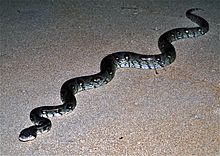
Sanzinia madagascariensis, also known as the Madagascar tree boa or Malagasy tree boa, is a boa species endemic to the island of Madagascar. It was once considered conspecific with the Nosy Komba ground boa (Sanzinia volontany). Like all other boas, it is non-venomous. (Full article...) -
Image 21
Liasis mackloti, commonly known as Macklot's python or the freckled python, is a species of python, a non-venomous snake in the family Pythonidae. The species is endemic to Indonesia, East Timor, Papua New Guinea, and coastal northern Australia. Three subspecies are recognized, including the nominate subspecies described here. (Full article...) -
Image 22

Ovophis okinavensis, commonly known as the hime habu (ヒメハブ), Ryukyu Island pit viper, and the Okinawan pitviper, is a pit viper species found in the Ryukyu Islands of Japan. No subspecies are currently recognized. (Full article...) -
Image 23

The king cobra (Ophiophagus hannah) is a species complex of snakes endemic to Asia. With an average of 3.18 to 4 m (10.4 to 13.1 ft) and a record length of 5.85 m (19.2 ft), it is the world's longest venomous snake and among the heaviest. Under the genus Ophiophagus, it is not phylogenetically a true cobra despite its common name and some resemblance. Spanning from the Indian Subcontinent through Southeastern Asia to Southern China, the king cobra is widely distributed albeit not commonly seen. (Full article...) -
Image 24Keelback may refer to any of the following snake genera:
- Amphiesma
- Amphiesmoides, a monotypic genus in the Colubridae with its sole representative, the white-eyed keelback, Amphiesmoides ornaticeps
- Atretium, a monotypic genus in the Colubridae with its sole representative, the split keelback, Atretium schistosum
- Fowlea
- Hebius
- Rhabdophis
- Helicops
- Herpetoreas
- Opisthotropis
- Pseudagkistrodon, a monotypic genus in the Colubridae with its sole representative, the red keelback, Pseudagkistrodon rudis
- Trimerodytes
- Tropidonophis
- Xenochrophis
-
Image 25
Selected lizard articles
-
Image 1Mangaon, Maharashtra, India
The Bengal monitor (Varanus bengalensis), also called the Indian monitor, is a species of monitor lizard distributed widely in the Indian subcontinent, as well as parts of Southeast Asia and West Asia. (Full article...) -
Image 2West Indian iguana may refer to: (Full article...)
-
Image 3
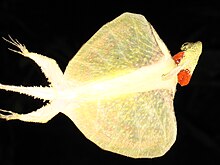
Draco norvillii, also known as Norvill's flying lizard, is species of agamid flying lizard endemic to India. This species is capable of gliding from tree to tree, and has been recorded gliding up to 50 metres (160 ft). It feeds on insects and other small invertebrates. (Full article...) -
Image 4
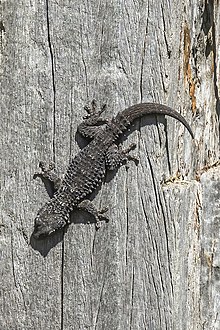
Tarentola mauritanica, known as the common wall gecko, is a species of gecko (Gekkota) native to the western Mediterranean area of North Africa and Europe. It has been introduced to Madeira and Balearic Islands, and the Americas (in Montevideo, Buenos Aires and California). A nocturnal animal with a predominantly insectivorous diet, it is commonly observed on walls in urban environments in warm coastal areas; it can be found further inland, especially in Spain where it has a tradition of cohabitation with humans as an insect hunter. A robust species, up to 15 centimetres (5.9 in) long, its tubercules are enlarged and give the species a spiny armoured appearance. (Full article...) -
Image 5
Draco spilonotus, the Sulawesi lined gliding lizard, is a lizard endemic to Sulawesi. The species is known from various localities in forested areas of Sulawesi. (Full article...) -
Image 6
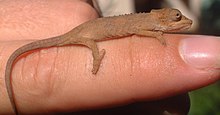
Setaro's dwarf chameleon (Bradypodion setaroi) is a species of lizard in the family Chamaeleonidae. (Full article...) -
Image 7
The gold dust day gecko (Phelsuma laticauda) is a diurnal species of gecko. It lives in northern Madagascar, the Comoro Islands, and the Mascarene Islands; it has also been introduced to Hawaii and other Pacific islands. It is primarily an arboreal species which can be found in tropical forests and may also associate with human dwellings. The gold dust day gecko feeds on insects and nectar. (Full article...) -
Image 8

The Namaqua dwarf chameleon or the western dwarf chameleon (Bradypodion occidentale) occurs in beach vegetation, along the west coast of South Africa and Namibia. (Full article...) -
Image 9

The Transvaal dwarf chameleon (Bradypodion transvaalense) is a chameleon native to South Africa, where it is found in forested areas of Mpumalanga and Limpopo provinces. It is also known as the Wolkberg dwarf chameleon, after the Wolkberg range. (Full article...) -
Image 10
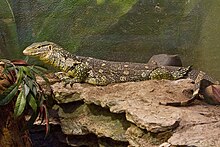
The ornate monitor (Varanus niloticus ornatus) is a monitor lizard that is native to West and Middle Africa. Comprehensive molecular analyses of the group have demonstrated that animals previously assigned to "Varanus ornatus" do not constitute a valid taxon and are actually polymorphisms of two different species; Varanus stellatus (west African Nile monitor) and Varanus niloticus (Nile monitor). Consequently, Varanus ornatus is considered a synonym of Varanus niloticus and "ornate monitor" is an informal term for forest forms of either species (V. niloticus or V. stellatus).
Until 1997, the ornate monitor was considered a subspecies of the Nile monitor. It was subsequently described as a separate species on the basis of reduced number of ocelli rows on the body, a light coloured tongue and a more massive build. More recent work based on a large sample size using mitochondrial and nuclear DNA sequences indicates that Varanus ornatus is not a valid species and that animals with the diagnostic appearance belong either of two sister species of Nile monitor. Animals described as ornate monitor lizards are native to closed canopy forests in West and Middle Africa. (Full article...) -
Image 11

The black rough-necked monitor (Varanus rudicollis) is a species of monitor lizard found in Southeast Asian countries of Thailand, Burma, and Malaysia. It is also found in Indonesia on Sumatra and islands of the Riau Archipelago It is sometimes known simply as the roughneck monitor. In Thailand is called h̄èā cĥāng (Thai: เห่าช้าง; "elephant bark"). (Full article...) -
Image 12The short-limbed bend-toed gecko (Mediodactylus brachykolon) is a species of gecko. The gecko is distinguished from others due to its distinctly short limbs, stout body and large head. In appearance it is similar to Altiphylax stoliczkai and Altiphylax baturensis.
The name of the gecko comes from Greek brachys meaning short and kolon meaning limb. (Full article...) -
Image 13

Smith's dwarf chameleon (Bradypodion taeniabronchum), also known as the Elandsberg dwarf chameleon, is a species of lizard in the family Chamaeleonidae endemic to Fynbos in South Africa's Eastern Cape. As in several species of chameleons in the genus Bradypodion, the Smith's dwarf chameleon can use its color-changing ability to actively camouflage itself depending on the vision of the specific predator species (for example, bird or snake) by which it is being threatened. (Full article...) -
Image 14A male rhinoceros iguana, Pedernales, Dominican Republic
The rhinoceros iguana (Cyclura cornuta) is an endangered species of iguana that is endemic to the Caribbean island of Hispaniola (shared by Haiti and the Dominican Republic) and its surrounding islands. A large lizard, they vary in length from 60 to 136 centimetres (24 to 54 in), and skin colours range from a steely grey to a dark green and even brown. Their name derives from the bony-plated pseudo-horn or outgrowth which resembles the horn of a rhinoceros on the iguana's snout. It is known to coexist with the Ricord's iguana (C. ricordii); the two species are the only taxa of rock iguana to do so. (Full article...) -
Image 15
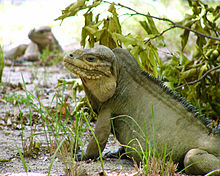
The Mona ground iguana (Cyclura stejnegeri) is a critically endangered species of rock iguana, endemic to Mona Island, Puerto Rico. It is one of the island nation's few large land animals, and it is the largest endemic terrestrial lizard in the country, and one of the biggest rock iguanas within the Antilles. It was previously considered a subspecies of the rhinoceros iguana (Cyclura cornuta). (Full article...) -
Image 16A Lesser Antillean iguana in Coulibistrie, Dominica
The Lesser Antillean iguana (Iguana delicatissima) is a large arboreal lizard endemic to the Lesser Antilles. It is one of three species of lizard of the genus Iguana and is in severe decline due to habitat destruction, introduced feral predators, hunting, and hybridization with its introduced sister species, the green iguana (Iguana iguana). Successful captive breeding of this species has been limited to only two instances, as most captive-laid eggs tend to be infertile. (Full article...) -
Image 17
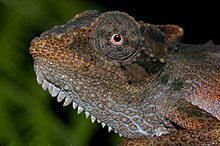
The Zululand dwarf chameleon (Bradypodion nemorale) is a species of lizard in the family Chamaeleonidae. It is also known as the Qudeni dwarf chameleon.
It is endemic to South Africa. (Full article...) -
Image 18

Draco melanopogon, commonly known as the black-bearded gliding lizard or black-barbed flying dragon, is a species of agamid "flying lizard" endemic to Southeast Asia. It is a typically forest-dwelling arboreal lizard. It preys on small invertebrates like ants and is oviparous. They are notable for relying solely on dewlap-mediated communication, instead of conveying signals via both headbobbing and employing dewlaps, as is typical for lizards with dewlaps. (Full article...) -
Image 19

Sphaerodactylus ariasae, commonly called the Jaragua sphaero or the Jaragua dwarf gecko, is the smallest species of lizard in the family Sphaerodactylidae. (Full article...) -
Image 20
Brachylophus bulabula, commonly known as the Central Fijian Banded Iguana is a species of iguanid lizard endemic to some of the larger central and northwestern islands of Fiji (Ovalau, Kadavu and Viti Levu), where it occurs in Fijian wet forest. It was described by a team led by a scientist from the Australian National University in 2008. It is one of the few species of iguana found outside of the New World and one of the most geographically isolated members of the family Iguanidae. Initially also reported from Gau Island, in 2017 this population was described as a separate species, B. gau. They can grow up to 2 feet long and have an average lifespan of 10-15 years. However, there have been some captive Fiji banded iguanas that have lived as long as 25 years. Fijian banded iguana typically are found in tropical wet islands that are typically 650-1700 feet above sea level. They also like to bask in temperatures ranging from 75–95 °F (24–35 °C). The areas that are most suitable for Fiji banded iguanas are Viti Levu, Vanua Levu, Ovalau, Viwa, and Kadavu. Males are typically are green with blue stripes and the females are green with white stripes. (Full article...) -
Image 21
The tokay gecko (Gekko gecko) is a nocturnal arboreal gecko in the genus Gekko, the true geckos. It is native to Asia and some Pacific Islands. (Full article...) -
Image 22
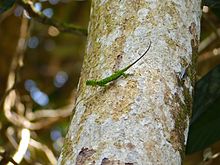
Draco cornutus is a species of "flying dragon", an agamid lizard. It is endemic to Borneo. It occurs at elevations up to 700 m (2,300 ft) above sea level, although its distribution is poorly known. (Full article...) -
Image 23
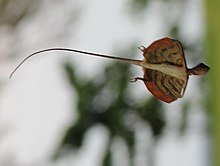
Draco taeniopterus, the Thai flying dragon, barred flying dragon, or barred gliding lizard, is a species of agamid lizard. It is found in Myanmar, Thailand, Cambodia, and Malaysia. (Full article...) -
Image 24
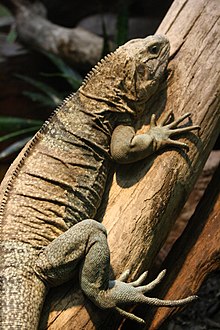
The Jamaican iguana (Cyclura collei), also known commonly as Colley's iguana, is a large species of lizard in the family Iguanidae. The species is endemic to Jamaica. It is critically endangered, even considered extinct between 1948 and 1990. Once found throughout Jamaica and on the offshore islets Great Goat Island and Little Goat Island, it is now confined to the forests of the Hellshire Hills. (Full article...) -
Image 25
The Komodo dragon (Varanus komodoensis), also known as the Komodo monitor, is a large reptile of the monitor lizard family Varanidae that is endemic to the Indonesian islands of Komodo, Rinca, Flores, and Gili Motang. It is the largest extant species of lizard, with the males growing to a maximum length of 3 m (9.8 ft) and weighing up to 150 kg (330 lb). (Full article...)
Selected turtle articles
-
Image 1
The Argentine snake-necked turtle (Hydromedusa tectifera), also known commonly as the South American snake-necked turtle is a species of turtle in the family Chelidae. The species is known for the long neck to which its common names refer. Despite appearances, the Argentine snake-necked turtle is probably more closely related to the mata mata (Chelus fimbriatus) than to the Australian snake-necked turtles in the genus Chelodina. H. tectifera is found in northern Argentina, Uruguay, Paraguay, and southern Brazil. Not much is known about it, as it has not been extensively researched. It is a popular pet in the exotic pet trade. (Full article...) -
Image 2The Apalachicola snapping turtle (Macrochelys apalachicolae) is a proposed species that lives in the Apalachicola River, United States. The proposed species can as well be found within other panhandle rivers within the states of Florida, Georgia, and Alabama. (Full article...)
-
Image 3Eastern box turtle in Southern Illinois
The eastern box turtle (Terrapene carolina carolina) is a subspecies within a group of hinge-shelled turtles normally called box turtles. T. c. carolina is native to the Eastern United States. (Full article...) -
Image 4A green sea turtle swimming above a Hawaiian coral reef
The green sea turtle (Chelonia mydas), also known as the green turtle, black (sea) turtle or Pacific green turtle, is a species of large sea turtle of the family Cheloniidae. It is the only species in the genus Chelonia. Its range extends throughout tropical and subtropical seas around the world, with two distinct populations in the Atlantic and Pacific Oceans, but it is also found in the Indian Ocean. The common name refers to the usually green fat found beneath its carapace, due to its diet strictly being seagrass, not to the color of its carapace, which is olive to black. (Full article...) -
Image 5
The yellow-headed temple turtle (Heosemys annandalii) is a large species of turtle in the family Geoemydidae. The species is native to Southeast Asia. (Full article...) -
Image 6
The Escambia map turtle (Graptemys ernsti), also known commonly as Ernst's map turtle, is a species of turtle in the family Emydidae. The species is endemic to the United States. (Full article...) -
Image 7

The eastern long-necked turtle (Chelodina longicollis) is an east Australian species of snake-necked turtle that inhabits a wide variety of water bodies and is an opportunistic feeder. It is a side-necked turtle (Pleurodira), meaning that it bends its head sideways into its shell rather than pulling it directly back. (Full article...) -
Image 8
The wood turtle (Glyptemys insculpta) is a species of turtle in the family Emydidae. The species is native to northeastern North America. The genus Glyptemys contains only one other species of turtle: the bog turtle (Glyptemys muhlenbergii). The wood turtle reaches a straight carapace length of 14 to 20 centimeters (5.5 to 7.9 in), its defining characteristic being the pyramidal shape of the scutes on its upper shell. Morphologically, it is similar to the bog turtle, spotted turtle (Clemmys guttata), and Blanding's turtle (Emydoidea blandingii). The wood turtle exists in a broad geographic range extending from Nova Scotia in the north (and east) to Minnesota in the west and Virginia in the south. In the past, it was forced south by encroaching glaciers: skeletal remains have been found as far south as Georgia. (Full article...) -
Image 9
The Florida box turtle (Terrapene carolina bauri) is a subspecies of turtle belonging to the family Emydidae and is one of six extant subspecies of the common box turtle (T. carolina) (Full article...) -
Image 10
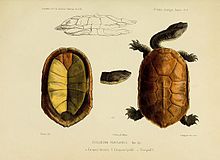
The Brazilian snake-necked turtle (Hydromedusa maximiliani ), locally known as cágado da serra, and also commonly known as Maximilian's snake-necked turtle, is a species of turtle in the family Chelidae. The species is endemic to southeastern Brazil. It is one of the smallest Brazilian freshwater turtles reaching a maximum straight carapace length of 20 cm (7.9 in). The species prefers streams with sandy and rocky bottoms and clear water in forests above 600 m (2,000 ft) elevation. (Full article...) -
Image 11

The Vallarta mud turtle (Kinosternon vogti) is a recently identified species of mud turtle in the family Kinosternidae. While formerly considered conspecific with the Jalisco mud turtle, further studies indicated that it was a separate species. It can be identified by a combination of the number of plastron and carapace scutes, body size, and the distinctive yellow rostral shield in males. (Full article...) -
Image 12

The black softshell turtle or Bostami turtle (Nilssonia nigricans), previously placed in genus Aspideretes, is a species of freshwater turtle found in India (Assam and Tripura) and Bangladesh (Chittagong and Sylhet). It was long believed to consist of inbred individuals of the Indian softshell turtle (A. gangeticus or N. gangeticus) or the Indian peacock softshell turtle (A. hurum or N. hurum), but while it is a close relative of the latter, it is a distinct species. In the 1800s it was believed these turtles were brought from Iran to Chittagong shrine pond by Hazrat Bayezid Bostami. His turtles he had brought to this pond were treated as sacred and respected by the public. Previously declared extinct by the International Union for Conservation of Nature in 2002, these turtles were found still to exist in a temple's pond called the Hayagriva Madhava Temple located in Assam, and in Kalyan Sagar lake in Tripura Sundari Temple in Udaipur, Tripura, India. Through conservation methods and protection of the species, some of these turtles can be found today throughout the wild, and scientists and environmental biologists are continuing to work hard to preserve this endangered species and their natural habitat. Their mitogenome represents relatedness to 19 other species of the Testudines. When looking at the phylogenetic tree, Nilssonia nigricans is a sister group to Nilssonia formosa. (Full article...) -
Image 13
The Japanese pond turtle (Mauremys japonica), also called commonly the Japanese pond terrapin and the Japanese pond tortoise, is a species of turtle in the family Geoemydidae endemic to Japan. Its Japanese name is nihon ishigame, Japanese stone turtle. Its population has decreased somewhat due to habitat loss, but it is not yet considered a threatened species. (Full article...) -
Image 14
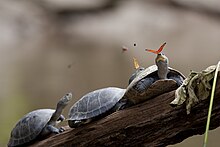
The red-headed Amazon side-necked turtle, red-headed river turtle or red-headed sideneck (Podocnemis erythrocephala) is a species of turtle in the family Podocnemididae. It is found in the Amazon basin in Brazil, Colombia, and Venezuela. The red-headed river turtle is considered a small turtle with a size of less than 32 cm, making it easily distinguishable from other species in the area. Identifying factors of this turtle include colors ranging from dark brown to black, barbels under the chin, and a bright red strip that goes from behind its head to the tympanum. (Full article...) -
Image 15
The narrow-bridged musk turtle (Claudius angustatus) is a species of turtle in the family Kinosternidae. The species is found in Central America and Mexico. (Full article...) -
Image 16
The Zambezi flapshell turtle (Cycloderma frenatum) is a species of softshell turtle in the family Trionychidae). Within its family, C. frenatum belongs to the smaller, and exclusively Old World, subfamily Cyclanorbinae. (Full article...) -
Image 17
The saw-shelled turtle (Myuchelys latisternum) is a species of turtle in the Chelidae family endemic to Australia, ranging along rivers and streams and connected swamps and lagoons from coastal Cape York Peninsula to northern New South Wales, with populations also noted as far south as Newcastle - (Williams River Catchment site of the former Tilligra Dam). They are thought to have been introduced to Lake Eacham in the Atherton Tablelands. Other common English names are: serrated snapping turtle or common sawshell turtle. (Full article...) -
Image 18
Siebenrockiella leytensis is a species of freshwater turtle endemic to the Philippines. It is classified as critically endangered. It is known as the Philippine forest turtle, the Philippine pond turtle, the Palawan turtle, or the Leyte pond turtle. Despite the latter common name, it does not occur in the island of Leyte but is instead native to the Palawan island group. It is locally known as bakoko in Cuyonon. (Full article...) -
Image 19The Fujian pond turtle ("Mauremys" × iversoni) is a possibly also naturally occurring intergeneric hybrid turtle in the family Geoemydidae (formerly Bataguridae). The Fujian pond turtle is produced in larger numbers by Chinese turtle farms as a "copy" of the golden coin turtle Cuora trifasciata. It appears to occur in China and Vietnam. Before its actual origin became known, it was listed as data deficient in the IUCN Red List. (Full article...)
-
Image 20
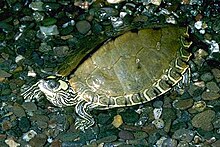
The Pascagoula map turtle (Graptemys gibbonsi) is a species of turtle in the family Emydidae. The species is native to the southern United States. (Full article...) -
Image 21
Kemp's ridley sea turtle (Lepidochelys kempii), also called commonly the Atlantic ridley sea turtle, Kemp's ridley turtle, and Kemp's ridley, is a species of turtle in the family Cheloniidae. L. kempii is the rarest species of sea turtle and is the world's most endangered species of sea turtle. It is one of two living species in the genus Lepidochelys (the other one being L. olivacea, the olive ridley sea turtle). The species L. kempii primarily occupies habitat around the Gulf of Mexico, though its migrations into the Atlantic Ocean are being affected by rising temperatures. Kemp's ridley sea turtle is listed as endangered under the Endangered Species Act (ESA), and conservation efforts are attempting to rebuild population numbers. Human activity, including but not limited to habitat destruction, climate change, and oil spills, threaten populations. (Full article...) -
Image 22Swamp turtle or swamp terrapin may refer to: (Full article...)
-
Image 23
The Mexican musk turtle (Staurotypus triporcatus), also known commonly as the giant musk turtle, is a species of turtle in the family Kinosternidae. The species occurs in Central America and Mexico. (Full article...) -
Image 24

The alligator snapping turtle (Macrochelys temminckii) is a large species of turtle in the family Chelydridae. The species is endemic to freshwater habitats in the United States. M. temminckii is one of the heaviest living freshwater turtles in the world. It is the largest freshwater species of turtle in North America. It is often associated with, but not closely related to, the common snapping turtle, which is in the genus Chelydra. The specific epithet temminckii is in honor of Dutch zoologist Coenraad Jacob Temminck. (Full article...) -
Image 25Red-cheeked mud turtle (K. s. cruentatum), in Quintana Roo, Mexico
The scorpion mud turtle or Tabasco mud turtle (Kinosternon scorpioides) is a species of mud turtle in the family Kinosternidae. It is found in Mexico, Central and South America. (Full article...)
Need help?
Do you have a question about Reptiles that you can't find the answer to?
Consider asking it at the Wikipedia reference desk.
Topics
Major extant reptile clades | |||||
|---|---|---|---|---|---|
| Lepidosauria | |||||
| Archelosauria |
| ||||
Related portals
Associated Wikimedia
The following Wikimedia Foundation sister projects provide more on this subject:
-
Commons
Free media repository -
Wikibooks
Free textbooks and manuals -
Wikidata
Free knowledge base -
Wikinews
Free-content news -
Wikiquote
Collection of quotations -
Wikisource
Free-content library -
Wikiversity
Free learning tools -
Wiktionary
Dictionary and thesaurus





